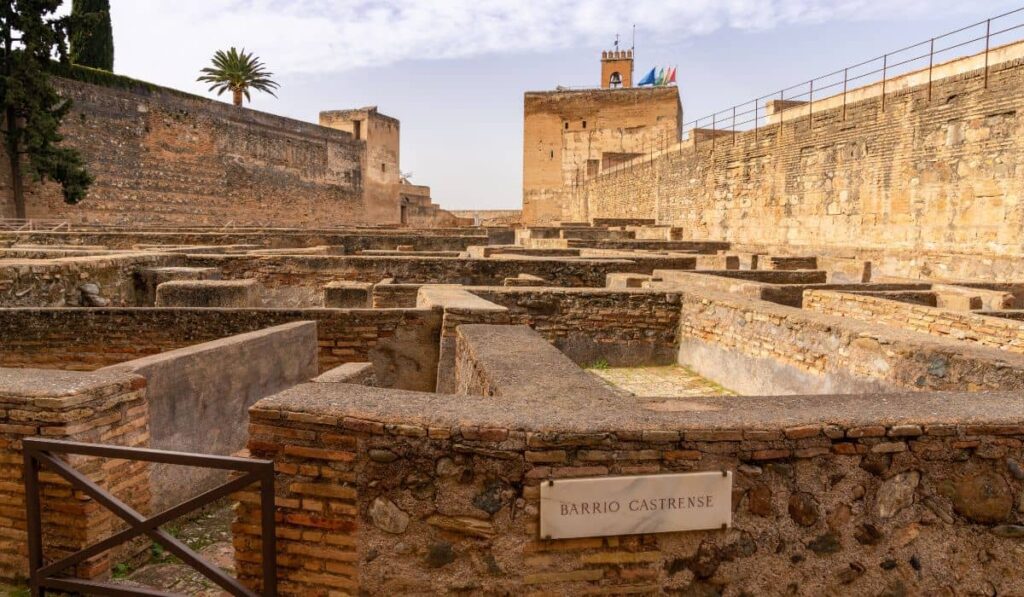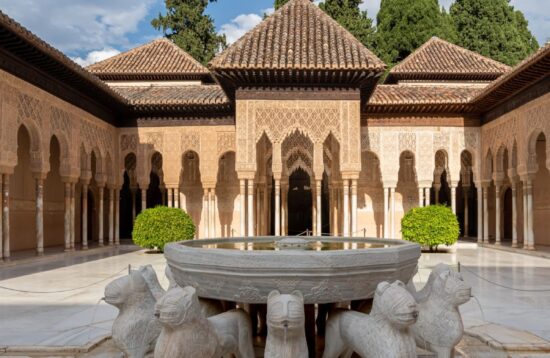
Alcazaba of Granada, the Soul of the Alhambra
The Alcazaba of the Alhambra in Granada, a majestic testimony of history, transports us through the centuries to a past full of mystery and grandeur. Its roots go back to the times of the Muslim occupation of the Iberian Peninsula, when it was erected as a military fortress during the 9th century, in the splendorous period of the Zirid Kingdom. Since then, it has witnessed the greatness of different rulers and has undergone transformations that have turned it into an architectural and cultural treasure of incalculable value. Discover all about the secrets that lie within its imposing walls!
History of the Alcazaba of Granada
With the arrival of the Nasrids to power in the 13th century, the Alcazaba underwent a significant transformation. The Nasrids converted the fortress into a palace complex, building new palaces, courtyards and gardens. This period saw the splendor of the Alhambra and its Alcazaba became the political and cultural center of the Kingdom of Granada.
During the reign of Muhammad I, important defensive structures were built in the Alcazaba, such as the Torre Quebrada and the Torre de la Vela, which offered strategic views and protection against possible invasions. Under Yusuf I, new palaces were added and the courtyards were embellished with fountains and gardens.
However, in 1492, the Catholic Monarchs conquered Granada and the Alhambra passed into Christian hands. During this period, the Alcazaba was used as military barracks and underwent some modifications to adapt to the needs of the new occupants.
With the passing of time, the Alcazaba lost importance and fell into a state of abandonment. Fortunately, in the 19th century, restoration and conservation work was begun to preserve this invaluable historical and cultural heritage.
Today, the Alcazaba of the Alhambra is one of the most visited tourist attractions in Spain and a living testimony to the rich history of Granada. Through its architecture and succession of rulers, the Alcazaba transports us to different eras and allows us to appreciate the mix of cultural influences that have left their mark on this magnificent complex.

Legends and Myths of the Alcazaba of Granada
The Alcazaba of the Alhambra in Granada is a place wrapped in an aura of mystery and fascination, where legends and myths intertwine with history to weave a tapestry of captivating narratives. Over the centuries, numerous stories have emerged that have left an indelible mark on popular tradition and have contributed to the halo of romanticism that surrounds this emblematic place.
One of the best known legends is that of “Boabdil el Chico”, the last Muslim king of Granada. It is said that, upon being expelled from the Alhambra by the Catholic Monarchs in 1492, Boabdil stopped at a high point known as “El Suspiro del Moro” to contemplate his beloved city for the last time. It is said that he sighed with sadness as he left behind the palace and the lands he ruled, and that his mother told him: “Cry like a woman what you did not know how to defend like a man”. This phrase has gone down in history as a symbol of the fall of the Kingdom of Granada.
Another legend that fascinates visitors and locals alike is the story of “La Sultana Aixa”. It is said that Aixa, mother of Boabdil, was a woman of great beauty and power who lived in the Alhambra. According to legend, she had a magic mirror that allowed her to see what was happening throughout the kingdom. However, her power and wisdom aroused the jealousy of others and, in an act of treachery, her mirror was destroyed. It is said that Aixa still wanders the corridors of the Alcazaba, desperately searching for the fragments of her lost mirror.
In addition to these legends, the Alcazaba of the Alhambra is also steeped in stories of forbidden loves and secret encounters. One of them is the story of “The Lady of the Alhambra”, a Muslim princess who fell madly in love with a Christian knight. Their love was impossible, as they belonged to conflicting religions and cultures. Despite the barriers, they met in the Alcazaba in the dark of night, in a secret corner where they could live their forbidden love. It is said that their sighs of love can still be heard in the silent nights of the Alhambra.
These legends and myths, passed down through generations, endow the Alcazaba of the Alhambra with an aura of enigma and romance. They invite us to immerse ourselves in a world of intrigues, passions and supernatural events that have left their mark on the centuries-old walls. Visiting this historic place, we can imagine the whispers of clandestine lovers and feel the palpitation of a magical story that transcends time.
Cultural Significance
The Alcazaba of the Alhambra in Granada transcends its architectural beauty and historical relevance to become a cultural treasure of immense value. Its importance as a World Heritage Site lies in its ability to transmit and preserve the rich heritage of Islamic civilization in the Iberian Peninsula.
This imposing fortress and royal palace is a living testimony to the fusion of cultures and architectural styles that intertwined in medieval times. Its intricate design, with courtyards, gardens, fountains and decorative tiles, reflects the mastery of the Muslim artists and craftsmen who built it.
The Alcazaba of the Alhambra is also a symbol of the flourishing of Islamic culture in the region of Al-Andalus. During its heyday, it became an intellectual and artistic center, attracting scholars, poets and musicians. It was a place where poetry and music mingled with architecture and gardens, creating an atmosphere of inspiration and creativity.
In addition, the Alcazaba of the Alhambra is a testimony to the coexistence of different cultures and religions in the history of Spain. Its capture by the Catholic Monarchs in 1492 marked the end of the Muslim presence in the Iberian Peninsula, but it was also the beginning of a new era in which new identities and cultural syncretisms were forged.
The preservation of the Alcazaba of the Alhambra is crucial for future generations. Its value as a historical and cultural heritage transcends borders and connects people with their past. Every architectural detail, every inscription and every legend conveys knowledge and lessons that we must safeguard for generations to come.
In addition, the Alhambra and its Alcazaba attract millions of visitors each year, generating a significant economic and tourism impact. The proper conservation of this cultural treasure guarantees the continuity of its enjoyment and its contribution to the sustainable development of the region.
Visits and Tourism to the Alcazaba of Granada
The Alcazaba of the Alhambra is a must-see destination for lovers of history and architecture. To make the most of your visit, we recommend you to go to a tour guide to not miss anything on your visit, also keep in mind the following information and practical tips:
Opening hours of the Alcazaba of Granada
The Alcazaba is open to the public every day of the year, but opening hours may vary depending on the season. It is advisable to consult the Alhambra’s official website for the most up-to-date opening times. It is recommended to arrive early to avoid crowds and enjoy a quieter experience.
Recommendations of areas to explore
At the Alcazaba, don’t miss the Torre de la Vela, from where you can enjoy breathtaking panoramic views of Granada. Explore the courtyards and gardens, such as the Patio de los Leones and the Patio de los Arrayanes, with their fountains and ornamental details.
Combine the visit with other places of interest
In addition to the Alcazaba, the Alhambra is home to other fascinating areas, such as the Nasrid Palaces, the Generalife Gardens and the Palace of Charles V. Take advantage of your visit to explore these places and marvel at their unique beauty.
Touring the Alcazaba of the Alhambra is an enriching experience, where you can immerse yourself in the history and majesty of this emblematic place. Enjoy the Islamic architecture, the beautiful gardens and the decorative details that make this site a unique treasure. Combine your visit with other attractions in the Alhambra and create unforgettable memories of your trip to Granada.





